
The Prophet's Mosque is the second mosque built by the Islamic prophet Muhammad in Medina, after the Quba Mosque, as well as the second largest mosque and holiest site in Islam, after the Masjid al-Haram in Mecca, in the Saudi region of the Hejaz. The mosque is located at the heart of Medina, and is a major site of pilgrimage that falls under the purview of the Custodian of the Two Holy Mosques.

Mughal architecture is the type of Indo-Islamic architecture developed by the Mughals in the 16th, 17th and 18th centuries throughout the ever-changing extent of their empire in the Indian subcontinent. It developed from the architectural styles of earlier Muslim dynasties in India and from Iranian and Central Asian architectural traditions, particularly Timurid architecture. It also further incorporated and syncretized influences from wider Indian architecture, especially during the reign of Akbar. Mughal buildings have a uniform pattern of structure and character, including large bulbous domes, slender minarets at the corners, massive halls, large vaulted gateways, and delicate ornamentation; examples of the style can be found in modern-day Afghanistan, Bangladesh, India and Pakistan.
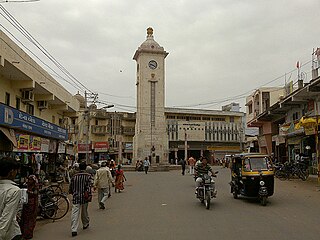
Khambhat, also known as Cambay, is a city and the surrounding urban agglomeration in Anand district in the Indian state of Gujarat. It was once an important trading center, but its harbour gradually silted up, and the maritime trade moved to Surat. Khambat lies on an alluvial plain at the north end of the Gulf of Khambhat, noted for the extreme rise and fall of its tides, which can vary as much as thirty feet in the vicinity of Khambat. Khambat is known for its halvasan sweet, sutarfeni, akik stone and kites (patang), and for sources of oil and gas.

Indo-Islamic architecture is the architecture of the Indian subcontinent produced by and for Islamic patrons and purposes. Despite an initial Arab presence in Sindh, the development of Indo-Islamic architecture began in earnest with the establishment of Delhi as the capital of the Ghurid dynasty in 1193. Succeeding the Ghurids was the Delhi Sultanate, a series of Central Asian dynasties that consolidated much of North, East, and Central India, and later by the Mughal Empire during the early 16th century. Both of these dynasties introduced Islamic architecture and art styles from West Asia into the Indian subcontinent.

Champaner-Pavagadh Archaeological Park, a UNESCO World Heritage Site, is located in Panchmahal district in Gujarat, India. It is located around the historical city of Champaner, a city which was founded by Vanraj Chavda, the most prominent king of the Chavda Dynasty, in the eighth century. He named it after the name of his friend and general Champa, also known later as Champaraj. The heritage site is studded with forts with bastions starting from the hills of Pavagadh, and extending into the city of Champaner. The park's landscape includes archaeological, historic and living cultural heritage monuments such as chalcolithic sites, a hill fortress of an early Hindu capital, and remains of the 16th-century capital of the state of Gujarat. There are palaces, entrance gates and arches, mosques, tombs and temples, residential complexes, agricultural structures and water installations such as stepwells and tanks, dating from the eighth to the 14th centuries. The Kalika Mata Temple, located on top of the 800 metres (2,600 ft) high Pavagadh Hill, is an important Hindu shrine in the region, attracting large numbers of pilgrims throughout the year.
Ghogha is a census town in Bhavnagar district in the state of Gujarat, India. It is situated on the mid-western bank of the Gulf of Khambhat. It was an important historical commercial port on the Arabian Sea until the development of nearby Bhavnagar in the nineteenth century.
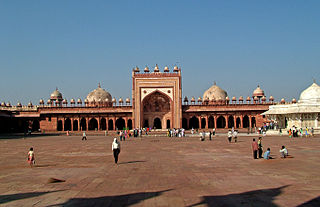
The Jama Masjid is a 16th-century congregational mosque in the UNESCO World Heritage Site of Fatehpur Sikri, located in Uttar Pradesh, India. It was built by Mughal emperor Akbar, and was the largest mosque in the empire at the time of construction. The Jama Masjid's design drew from earlier mosques built by various pre-Mughal sultanates, and served as an important precedent in subsequent Mughal architecture.

Sultan Ghari was the first Islamic Mausoleum (tomb) built in 1231 AD for Prince Nasiruddin Mahmud, eldest son of Iltumish, in the "funerary landscape of Delhi" in the Nangal Dewat Forest, Near Nangal Dewat Vasant Kunj).

Ibrāhīm bin Shahryar bin Zadan Farrokh bin Khorshid, better known by his pen-names Abū Ishaq (ابواسحاق) and Sheykh Abū Ishaq of Kazerun and Nicknamed Sheykh Murshid, was one of the famous Iraninan Sufis of the late 4th and early 5th century AH. He was the founder of the Kazeruniyeh sufism, which spread to India and China on one side, and to Anatolia and Baghdad on the other side.

Jama Masjid, also known as Jumah Mosque or Jami' Masjid, is a mosque in Ahmedabad, Gujarat, India. It was built in 1424 during the reign of Ahmad Shah I. The inscription on the central mihrab commemorates the inauguration of the mosque on the 1st Safar A.H. 827 or January 4, 1424 A.D. by Sultan Ahmad Shah I. The mosque lies in the old walled city, and it is situated outside Bhadra Fort area. The old walled city is divided into separate quarters or pols, and the Jami' Masjid is found on the Gandhi Road. Along the south side of the road, the mosque is a short distance beyond the Teen Darwaza or Tripolia Gate.
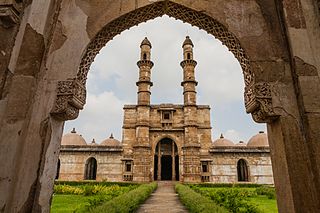
The Jami Masjid, also known as Jama Masjid; meaning "public mosque", is a former Friday mosque, now a well-preserved heritage site, located in Champaner, in the state of Gujarat, India. The mosque is a Monument of National Importance, and, together with other structures, is part of the Champaner-Pavagadh Archaeological Park, a UNESCO World Heritage Site, and is among the 114 monuments there which are listed by the Baroda Heritage Trust. The mosque is located approximately 46 metres (150 ft) east of the city walls (Jahdnpandh), near the east gate.

There are eleven different types of buildings at the UNESCO-protected Champaner-Pavagadh Archaeological Park in Gujarat, India, including mosques, temples, granaries, tombs, wells, walls, and terraces. The monuments are situated at the foot of and around the Pavagadh Hill. The Baroda Heritage Trust lists 114 monuments in the area, of which only 39 are maintained by the Archaeological Survey of India, due to limited funding. The Forest Department owns 94% of the land here, while the temple trusts and other sectarian establishments provide facilities for boarding and lodging to pilgrims and tourists. On the southern side near the foot of the hill some dilapidated houses and the foundations of Jain temples can also be seen.

The Lila Gumbaj Ki Mosque is a former mosque, now a heritage site, located in Champaner, in the state of Gujarat, India. The mosque is a Monument of National Importance, and, together with other structures, is part of the Champaner-Pavagadh Archaeological Park, a UNESCO World Heritage Site, and is among the 114 monuments there which are listed by the Baroda Heritage Trust. It is located near the east gate of the former city.

Persian Inscriptions on Indian Monuments is a book written in Persian by Dr Ali Asghar Hekmat E Shirazi and published in 1956 and 1958 and 2013. New edition contains the Persian texts of more than 200 epigraphical inscriptions found on historical monuments in India, many of which are currently listed as national heritage sites or registered as UNESCO world heritage, published in Persian; an English edition is also being printed.
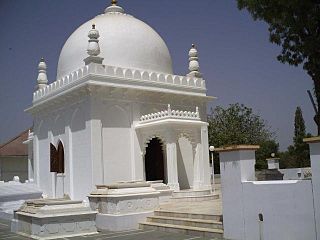
Abdallah was the first Isma'ili missionary in Gujarat.
Gujarat, a region in western India, fell under the Delhi Sultanate following repeated expeditions under Alauddin Khalji around the end of the 13th century. He conquered the Kingdom of Gujarat which had been under the rule of the Vaghela dynasty under Karna II and established Muslim rule in Gujarat. Soon the Tughluq dynasty came to power in Delhi whose emperor carried out expeditions to quell rebellion in Gujarat and established their firm control over the region by the end of the century. Following Timur's invasion of Delhi, the Delhi Sultanate weakened considerably so that the last Tughluq governor Zafar Khan declared himself independent in 1407 and formally established the Gujarat Sultanate.

Jamek Mosque, officially Sultan Abdul Samad Jamek Mosque is one of the oldest mosques in Kuala Lumpur, Malaysia. It is located at the confluence of the Klang and Gombak rivers and may be accessed via Jalan Tun Perak. The mosque was designed by British architect and soldier Arthur Benison Hubback, and built in 1909. It was the principal mosque of Kuala Lumpur until the construction of the national mosque Masjid Negara in 1965.
The Architecture of Gujarat consists of architecture in the Indian state of Gujarat.
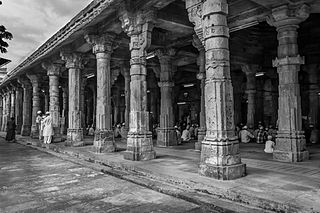
The Jami Masjid is a Friday mosque located at the top of the hill at Bharuch Fort in Bharuch, in the state of Gujarat, India. Built in the 14th century, it has three large domes, ten smaller domes and 48 pillars. The mosque was built in early 14th century; using the remains of a former Jain temple; and is a Monument of National Importance.

The Begumpur Mosque, also known as The Jam'i Masjid of Jahanpanah, was built in the center of the sultanate capital of the Tughluq dynasty, Jahanpanah. Its construction took place around the year 1343 A.D. This historical monument is located in an urban village called Begumpur, which now bears its modern name. The mosque is designed to be a Friday mosque reflecting its enormous size, measuring 307 ft by 295 ft.





















